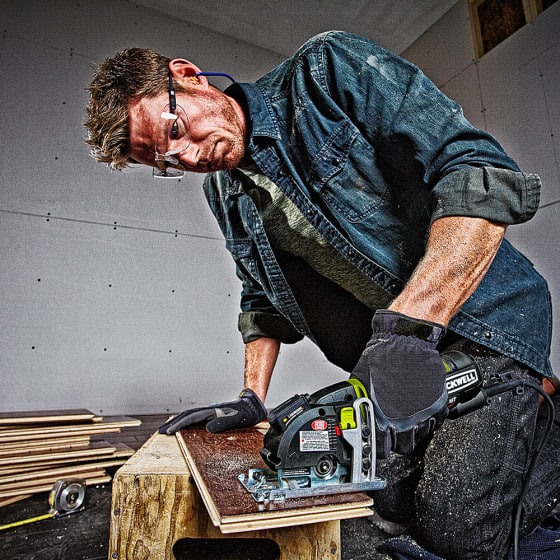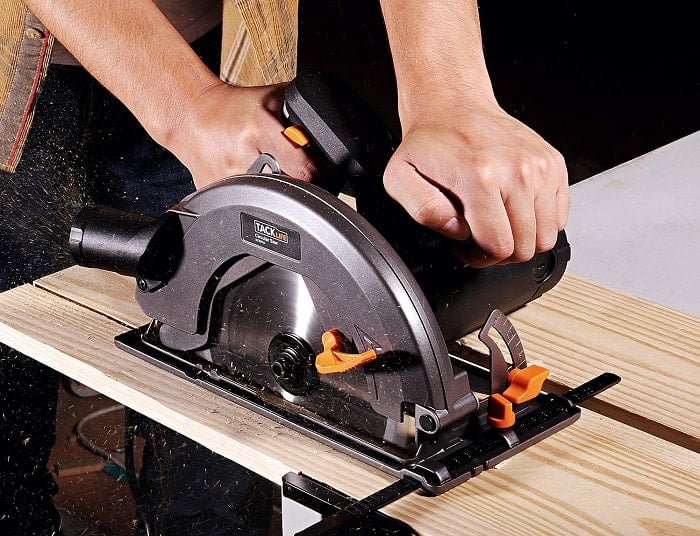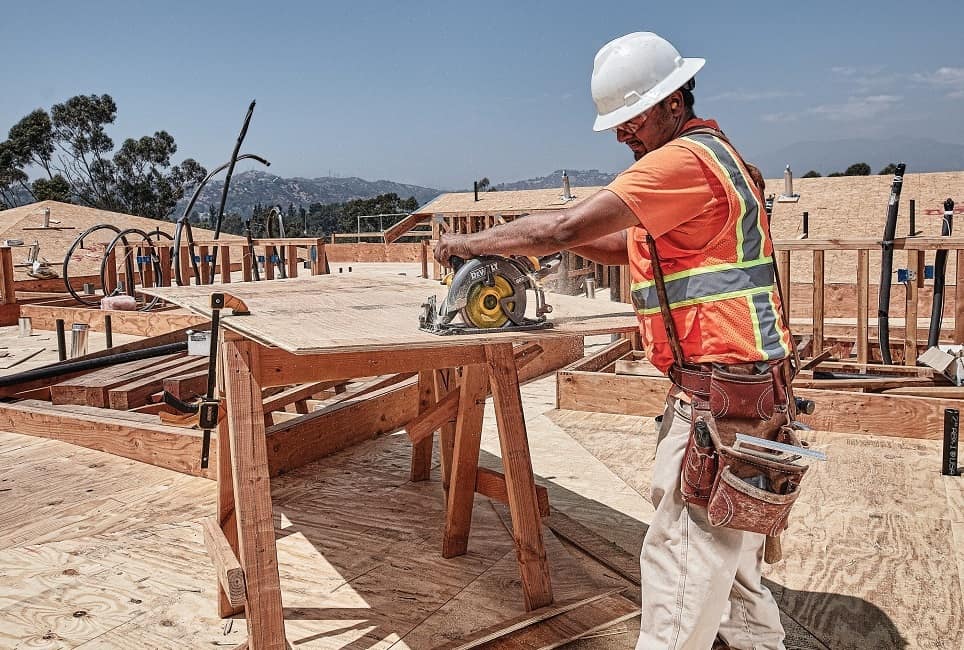- Eastwood TIG 200 Review: All You Need to Know! - June 25, 2022
- Best Drywall Sanders – How to Find Them and Which to Buy - June 25, 2022
- Makita vs Dewalt Drill – Which is the Best Brand? - June 24, 2022
On the surface, a track saw and a circular saw look very similar. They can both cut straight lines and angled cuts and both have a circular blade. They can both be used to cut a variety of materials. However, they are slightly different in their application. If you’re thinking of investing in one and you’re not sure which one to get, you’ve come to the right place.
In our track saw vs circular saw comparison, we’ll be taking an in-depth look at both of these powerful tools to see which one is best for you.
Whether you’re renovating, or you’re just into DIY as a hobby, a saw of some kind is a must-have. Whether you’re cutting sheets of wood to make a piece of furniture, cutting the deck to size, or creating smaller homemade projects, a power saw is great.
There are lots of different types – table saws, scroll saws, miter saws, band saws, cabinet saws, chop saws, which one will you choose? First, we’ll take a look at the main differences between a track saw and a circular saw, before we go into more detail about each one.
You can't go wrong with a Track Saw. Track Saws provide a professional finish with high accuracy and clean cuts. We recommend using the Makita Track Saw. Makita is famous for its tools. The SP6000J1 is no exception. It can produce accurate cuts with minimal tear-out, and it can work with different materials – melamine, wood, flooring, and more – to make smooth and precise cuts.
Main Differences Between Track Saw vs Circular Saw
The main differences between Track Saw vs Circular Saw are:
- Track Saw comes with a long track in front, whereas Circular Saw doesn’t
- Track saw is less portable and more limited, whereas Circular Saw is compact and more flexible.
- Track saw can make a crosscut, rip cut, and angle cut easily, whereas Circular Saw can make only crosscut and rip cut.
The bottom line is: if you want super-precise, accurate cuts, a track saw might be your best bet. They’re used by professionals, as they create very clean cuts with no rough edges. However, if you want something a little cheaper, easier to use and you’re not worried about the potential of slightly less accurate cuts, a circular saw could be for you.
Now, let’s take a look at track saws.
What is a Track Saw?
A track saw is a hand-held circular saw, with a long rectangular rail (the track). It slides on the rail as it operates, which will allow you to make precise, long cuts – it’s very easy to see what you’re doing with no rail guard to block your view, and the rubber strips on the bottom of the rail will hold your materials still as you work.
They’re becoming very popular with professionals, as they’re lightweight, easy to use, and very precise. The lack of a clamp may be a bit daunting at first, but you can buy clamps to hold things steady if necessary. The rubber grips work really well, though – so you shouldn’t need to buy a clamp, in theory.
- A track saw collects dust in a shroud – this is great to keep dust away from both you and your work surface, and it is then easy to dispose of the dust afterward. Another great point about a track saw is the setup: it’s time-consuming, but once you get going, it’s straightforward. You have to mark your materials, set the depth of cut, lay down the track, attach the dust bag, and start cutting.
- They save space – the saw itself is pretty small, and the tracks can be stacked upright. You can buy additional tracks and attach them together to cut very large pieces of material if you wish.
- You can complete angled cuts with a track saw – you can adjust the positioning to cut at any angle. It doesn’t have miter gauge built in – this means miter cuts might be a little slower as you will need to take your time to make the cut accurately. You can buy a miter gauge separately, which may help.
- The main plus point about track saws is the accuracy – they make very clean and precise cuts. They do, however, come with a higher price tag. They’re pretty expensive – this is the main downside, as the price may put it out of reach of those on a budget.
Our Recommendation – Makita SPJ6000J1 Plunge Cut Track Saw
Makita is known for making great-quality tools, and this is no exception. This Makita Track Saw can work with different materials – melamine, wood, flooring, and more – to make smooth precise cuts.
It has electronic speed control – this is great for keeping a steady speed throughout use. The Makita Track Saw SPJ6000J1 6-1/2 Inch Blade can cut large materials. It can make bevel cuts, and it’s easy to use. It has a fairly high price tag, but you may feel it’s worth it for the high quality.
You can't go wrong with a Track Saw. Track Saws provide a professional finish with high accuracy and clean cuts. We recommend using the Makita Track Saw. Makita is famous for its tools. The SP6000J1 is no exception. It can produce accurate cuts with minimal tear-out, and it can work with different materials – melamine, wood, flooring, and more – to make smooth and precise cuts.
Pros of Track Saws
- No blade guard – so it’s easy to see what you’re doing and it acts as anti-kickback to minimize the effect
- The rail holds everything steady, helping your cuts to be very precise
- Being able to set the depth of cut is very helpful
- Powerful 12 amp motor with large cutting capacity
- Powerful enough to cut through a variety of materials
- Light and portable
- Makes very smooth cuts with no jagged edges
Cons of Track Saws
- Higher price point than circular saws
- Takes a little while to set up
- Doesn’t include a riving knife which is good if you are working with thick solid wood

What is a Circular Saw?
A circular saw is a power saw, which uses a disc with teeth that spins around an arbor. It has a safety guard to protect the user as they work. They can be corded or cordless – cordless models come with rechargeable batteries.
- They’re pretty versatile, as you can get a variety of blades to cut through different types of materials. It can handle cross-cuts and rip cuts with ease.
- They’re pretty fast and easy to use – if you need to cut through a large amount of material, making lots of cuts, it could work well for you.
- There are a few different types of the circular saw:
Sidewinder Circular Saw
A sidewinder circular saw is very quick to use. It’s ideal for left-handed users due to the positioning of the motor. The motor is used in line with the circular saw blade, which allows it to move very quickly. It also has a high RPM (rotations per minute), and it’s good to use with softwood.
Worm drive Circular Saw
A worm drive uses a series of gears to reduce the speed. It has more torque (the force a tool uses to turn an object). The motor is placed behind the circular saw blade – this makes it easier to use for right-handed people.
Hypoid Circular Saw
A Hypoid circular saw has the motor behind the saw. They have a smaller motor than the others, but they’re still pretty powerful. The smaller motor means it is slightly less noisy to use. It also doesn’t need oiling, which could be a plus point.
Our Recommendation – DeWalt DCS577B
In terms of recommendations, we’d recommend the DeWalt DCS577B. DeWalt makes excellent tools, and this is definitely one of them. It is a cordless circular saw, meaning it’s a little more portable and easy to maneuver. It is a rear-handed circular saw (giving a great line of sight), with a brushless motor. The DCS577B can give up to a whopping 5,800 RPM – this is incredibly fast.
- It has an electronic brake, which his great, also, It can make bevel cuts and cutting depth of 2-7/16 inches.
- It has a built-in dust blower, which is a great feature.
Dewalt makes excellent tools, and the Dewalt DCS577B is definitely one of them. It is a cordless circular saw which makes it easy to maneuver. It can give up to a whopping 5,800 RPM.
Pros of a Circular Saw:
- Versatile – it can handle lots of different cuts with ease
- Different models allow ease of use for both left-handed and right-handed users
- Cheaper than a track saw
- Cuts very quickly
Cons of a Circular Saw:
- The cuts are rougher than cuts made by a track saw
- May not be as accurate

Types of Saw Blade
Here’s a quick overview of the different types of saw blade you can buy:
- Framing Blade – these are the most commonly used blades. They usually have 18-24 teeth, and can give a pretty good cut (although they may be a bit rough).
- Finishing Blades – These have more teeth, and are designed to make smoother cuts. This is great when you want a nice smooth finish.
- Metal Cutting Blades – These are either abrasive, or they have teeth. Abrasive cutting blades are inexpensive blades designed to cut through metal. The blade will wear down over time. Metal cutting with blades are more expensive but give fewer sparks as you use them.
- Cement Fiberboard Blades – These are designed to saw through cement fiberboards. They have very few teeth in comparison to the other types.
- Diamond Blades – these are used for masonry materials. They’re very strong and can cut through tough materials, like cement
- Heavy General Purpose Blades – these have fewer teeth and are good for cutting through tougher materials (like plywood) than framing blades. They can make rip cuts and crosscuts.
- Rip Blades – these are best for wood ripping.
- Teflon Coated Blades – these are coated in Teflon and are great for jobs that will create a lot of friction. They cannot be used for rip cuts, however.
- Thin Kerf Blades – these are designed to be long-lasting, reducing overheating even when using them on tough materials.
- Precision Trim Saw Blades – as the name suggests, this is for fine crosscuts.
- Glue Rip Blades – these are ripping blades, used for woodwork that needs to be glued afterward. They create a very smooth finish – perfect for using glue afterward.
- Laminate Blades – these are designed to cut through laminate without riving the veneer.Circular Saw Blades from Hardwareworld.comCheck Price
Hardware World carries a large selection of circular saw blades to choose from that are designed to fit most models and sizes of circular saws. Whether you're an enterprising homeowner looking to complete a DIY home improvement project or a licensed professional that relies on their commercial circular saw, you'll find the replacement blades you need to cut through even the toughest materials at Hardware World.
We earn a commission if you click this link and make a purchase at no additional cost to you.
What to Look for When Purchasing a Track Saw or a Circular Saw
There are a few things you may want to look out for when you’re purchasing either a track saw or a circular saw:
Torque
Torque is the word that describes the force a tool uses to turn an object. It is is measured in. Lbs, and it shows how powerful your tool is (and therefore, what types of material it can work with).
RPM
RPM stands for rotations per minute. It tells you how fast your blade will rotate. You will want to use different speeds for different types of materials – so having a variable speed dial is a great feature.

Bevel Capacity
This is a setting similar to cutting depth capacity. A beveled edge is any kind of structure that is not perpendicular to the face of the piece – it’s common to use beveled cuts to soften an edge, making it look more attractive. Different types of saws offer different bevel capacities.
Soft Start
Soft start allows your tool to warm up slightly before you start cutting, starting slow and then increasing in speed, rather than starting at full pelt. This should increase your accuracy.
Left-Handed or Right-Handed?
Some tools are better suited for left-handed users than others (this is especially true of circular saws). It’s best to check this beforehand.
What Size of Material Can You Cut?
You may need to cut large pieces of material, like large sheets of wood or MDF. In which case, you want to make sure your saw can deal with bigger pieces. A track saw rails can be put together, meaning you can make long cuts.
Does it Need Oil?
You need to oil some types of saw as part of their regular maintenance and to keep them running smoothly. Make sure you get the right type of oil for the machine.
Corded or Cordless Circular Saws?
Do you want a corded or cordless model of saw? Cordless circular saws will offer more flexibility, allowing you to move more freely. They tend to be less powerful; however – a corded model may be able to work with tougher materials.
Is it Portable?
How much does your tool weigh? Is it easy to carry? The only issue with a track saw is that you have to carry the rails separately – they are very light, however. Some models come with a handy bag or case to carry everything in – this is great if you’re doing DIY on the move.

What About Dust Collection?
How does your model of saw collect dust? Dust is a problem when you’re cutting lots of pieces of wood, for example. Track saws have dust port collection bags, which is great. Some models of circular saw have built-in dust port blowers, too.
Does it Have LED Lighting?
Some models of saw have LED lighting, to help increase accuracy as you work. This is really helpful if you are working in less than ideal lighting conditions.
Does it Have an Electric Brake?
Some models of saw have an electric brake – this is a really important safety feature. It stops the saw from spinning much more quickly than it would naturally – in roughly two seconds, as opposed to twelve seconds or more. This is really important if something goes wrong – you want it to stop spinning as quickly as possible.
How to Stay Safe When Using a Saw
It can be dangerous to use a track saw, or a table saw. Here are a few tips to stay safe:

Protect Your Eyes and Ears
The first issue with using a powered saw is dust – some types of saws (like track saws) have dust collection features, but some don’t. If your project is creating a lot of dust, it may be worth wearing a mask to stop you from breathing it in. You could also wear safety glasses to avoid it, getting in your eyes.
There’s also the risk of hearing damage over time. This is especially true if you’re working with tougher materials, like metals. Ear protection will help to safeguard your hearing for the future.
Store Your Saw Safely
It goes without saying, but it’s so important to store your saw (especially the blades) safely, where nobody can trip over it or accidentally hurt themselves.
Check for Loose Clothing, Jewellery, etc
Make sure you don’t wear anything that could dangle near the saw blade, like ties, jewelry, and loose clothing. Tie your hair back if it’s long enough, too.
Check for Objects in Materials
Make sure that you check your materials for stray screws, hinges, etc., that you may have missed.

FAQ’s About Track Saw vs Circular Saw
Yes. With frequent use eventually, it will come time to sharpen the blades of your track saw. The easiest way to do it is by using a file. However, if your saw has carbide-tipped blades, you will have to take it to a professional who will use a diamond wheel sharpener in order not to damage the blades.
Unfortunately no. Circular saw blades are not interchangeable and are not universal. They do come in more sizes, and are categorized differently in accordance with the material dept they can cut.
Many injuries occur when there is a kickback from the woodwork, so it is important to look for anti kickback technology to protect yourself while working with the proper equipment that it comes with the saw. You can also use a splinter or a push stick which will push the pieces of wood through the blade without having to risk yourself.
Conclusion
So, should you buy a circular saw or a track saw? It’s difficult to choose this time – although they look very similar, they’re actually quite different.
If you’re after a professional finish every time with expert accuracy and very clean cuts, you can’t go wrong with a track saw. They may take a little time to set up, but once you get going, a track saw is pretty simple to use. The Makita SPJ6000J1 Plunge Cut Track Saw is a great example of a brilliant plunge track saw – it works with great accuracy, has excellent reviews from users, and will work perfectly.
However, they’re expensive. This is what may put a lot of people off – it is pretty expensive, and that’s without extra blades and accessories, plus extra rails if you want to cut a particularly long piece.
Circular saws are a pretty handy tool to have. Although they make rougher cuts than a track saw, they do a pretty good job at many different cuts through varying types of material, and they work incredibly quickly – this is great if you’ve got a big volume of wood to cut through, for example. The lower cost makes it more realistic for your average home user – if you’re into DIY or you’re renovating, it could be a great tool to have.
The DeWalt DCS577B is a powerful, multi-purpose circular saw – you can’t go far wrong with that. With that in mind, we are going to pick the circular saw as our winner today – we think it would meet many of your needs, and you can always upgrade to a track saw later if you want to.
You can't go wrong with a Track Saw. Track Saws provide a professional finish with high accuracy and clean cuts. We recommend using the Makita Track Saw. Makita is famous for its tools. The SP6000J1 is no exception. It can produce accurate cuts with minimal tear-out, and it can work with different materials – melamine, wood, flooring, and more – to make smooth and precise cuts.
Recommended Reads:
If you enjoyed this article, you might like our Scroll Saw vs Band Saw Comparison or our guide on finding the Ultimate Scroll Saw.










